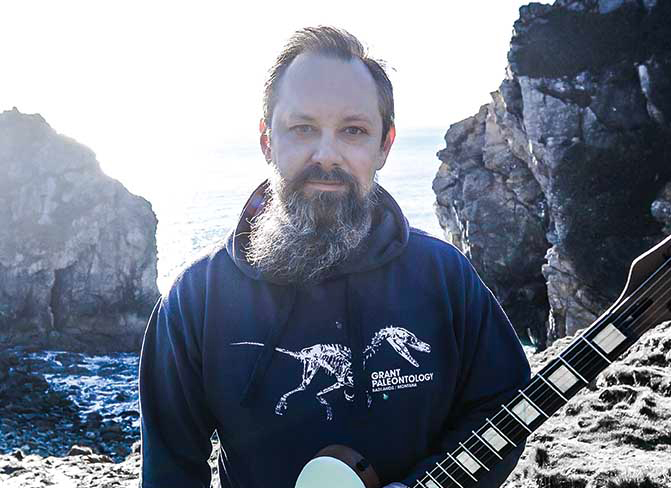His devastating riffs almost single-handedly invented djent, and his Allan Holdsworth-inspired solos blew an entire generation of guitarists’ minds: how Meshuggah’s Fredrick Thordendal changed the face of metal
One of the most influential guitar players of his generation, Thordendal’s low-end, rhythmically complex assaults have changed the shape and sound of metal

Born in 1970 in Umeå Sweden, Fredrik Thordendal formed Metallien, the band that would become Meshuggah in 1985.
Initially influenced by Metallica, the band evolved its sound by experimenting with rhythmic phrasing, incorporating concepts similar to King Crimson and Tool to create a a brand of progressive metal riffing which later became synonymous with the word ‘djent’.
Most of the musicians associated with the ‘D word’ however distance themselves from the term. Fredrik’s lead playing adds an extra dimension to Meshuggah’s music. It is heavily influenced by Allan Holdsworth, with fusion inspired legato and tapping lines and angular tapped flurries of notes.
Although Meshuggah music is typically played on seven and eight-string guitars, for the purposes of this lesson a standard tuned six-string is all you need. We will look at riffing and lead techniques employed by Fredrik and, as with most Meshuggah music, all of the examples can be rhythmically understood in two ways.
Technically everything is in 4/4, but the bars can be divided into odd numbered groupings which syncopate against the backbeat and patterns repeat across multiple measures.
It’s well worth taking the time to understand the basic arithmetic of each example in order to aid memorisation. The concept is that there are 16 16th notes per bar and our examples are three bars in length, giving us 48 notes to play with. These 48 notes can be divided into odd numbered patters, essentially ignoring the bar lines.
Our first example divides the 16th notes into threes, fives and sevens, with the added ingredient of starting each group with two 32nd notes for a more Thordendal style approach. Although this makes the riff more challenging to follow, gluing it all together is a solid 4/4 backbeat on the cymbals and snare, allowing the audience to nod their heads to this hypnotic style of metal.
All the latest guitar news, interviews, lessons, reviews, deals and more, direct to your inbox!
Our challenge is to keep track of the odd groupings, while simultaneously staying in time with the 4/4 bars. Example 2 is a legato lick with alternating seven and five-note groups with each group played on a new string, so the pattern should be relatively easy to execute.
Fredrik’s note choice usually derives from symmetrical diminished scales such as half-whole (1-2-b3-4-b5-#5-6-7), or whole-half (1-2-b3-4-b5-#5-6-b7), but these are just starting points. Fredrik also adds chromatic intervals outside of these scales for more angular and atonal effects. As the backing riffs are usually single notes or static powerchords, this leaves the tonality door wide open for any intervallic experiments.
Example 3 is a single-string tapping lick phrased in fives, while example 4’s tapping lick is phrased in threes on multiple strings. Fredrik often uses his fretting hand to repeat notes while the tapping hand explores various intervals on different strings. To finish, example 5 expands on this concept using five-note phrases across the strings.
Play each example slowly, counting the odd groupings, before practising feeling the licks across a 4/4 backbeat, before playing up to speed along with the backing tracks.
Get the tone
Amp Settings: Gain 8, Bass 3, Middle 5, Treble
Fredrik uses his signature Ibanez eight-string guitar with Lundgren M8 pickups providing the punch for the down-tuned riffs and legato soloing. Frerdrik’s amp is built by Fortin Amplification, but any modern high-gain tone should give you the sustain required for the examples, and you could add a chorus pedal and delay to give a more ‘fusion’ tone for the lead examples.
Example 1
Use the side of your picking hand to palm mute the strings at the bridge and play the 32nd and 16th-note subdivisions with alternate picking throughout.
The three bars are split into rhythmic subgroups which you can think of as four groups of three, three groups of five, and three groups of seven.
Example 2
This legato lick is based in B whole-half diminished scale (B-C#-D-E-F-G-G#-A#). Use hammer-ons, pull-offs and light picking to play through the notes evenly. Each string alternates between seven and five-note phrases played through straight 16th-note phrasing.
Example 3
This lick is based on a repeating five-note phrase comprising one tapped note and four legato notes. Across the three bars, Play the five-note phrasing nine times with a three-note phrase to finish. The key is to keep the 16th-note phrasing even throughout, even though the phrases always repeat on different off-beats.
Example 4
Use your fretting hand to hammer-on, pull-off and fretting-hand tap between the 9th and 10th frets. Between these two notes tap at the 15th and 16th frets to create groups of three 16th notes which repeat across the three bars. All being well there should be a total of 16 tapped notes across the three bars.
Example 5
This lick expands on the same techniques used in Ex 4 but this time uses a repeating five-note pattern played across the 16th-note phrasing. As you tap with the fretting and picking hands, keep your fingers light on the strings to enable the notes to flow smoothly.

Charlie Griffiths plays guitar in acclaimed prog-metal outfit Haken, and has a wealth of experience handling corporate and session gigs for genres as diverse as rock, heavy metal and pop. He has been a regular contributor to Total Guitar, Guitar Techniques and Guitar World for over fifteen years. His latest release is Tiktaalika - Gods of Pangaea which features stunning playing on, this time, 6-string guitars.

